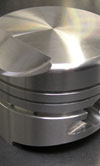Longevity and performance
 When Honda Performance Development (HPD) began plans to enter the Indy Racing League in 2003 with the Honda Indy V8, it built an engine that would have a service life of 600 miles, made to last from Carburetion Day at the Indianapolis Motor Speedway through the Indianapolis 500.
When Honda Performance Development (HPD) began plans to enter the Indy Racing League in 2003 with the Honda Indy V8, it built an engine that would have a service life of 600 miles, made to last from Carburetion Day at the Indianapolis Motor Speedway through the Indianapolis 500.
Much has changed since then, as HPD became sole engine supplier in the 2006 IndyCar Series season. Now the engines have a service life of 1400 race miles or 1600 absolute miles, as Roger Griffiths, manager of the development division at HPD, explains. So in piston development, he says, "We've gone through quite a lot, as we've looked at two different areas - reliability and performance.
"Obviously, we had to switch between a 3.5 litre and a 3 litre engine, and the piston specification changed on that. The bore size never changed but the stroke did, which led to different pin positioning on the piston pins," he says.
Most of HPD's development went towards keeping the power output steady and extending reliability. "In the past four years it has been about maintaining the same performance level over a longer and longer period," Griffiths says. "These efforts have been in ensuring that when we take the piston out of the engine after 1600 miles, it is in one piece.
"The other challenge we had was when we switched from methanol to ethanol, so we had to learn a little bit about the combustion on the engine using ethanol. Ethanol is more sensitive to detonation, so we just backed off the compression with our pistons.
"We didn't need to change the cylinder head at all, so we changed the shape of the piston dome to use less material. We went a bit flatter so that there was less material in use," he says.
While HPD never reveals its supplier resources, it does acknowledge it has a single supplier, and that the relationship has been in play since the beginning of HPD's engine building experience in the Indy Racing League.
Griffiths also says the team decided on a double ring piston. "We get what we need with two rings," he says. "We've been able to design the piston in such a way that we really can identify trouble spots early in the going, and we don't have any particular issues that we are concerned about right now.
"We may run into some stability issues but over the past three years - based on the work we did in the first four years - it's the same piston we've been running since the start of the 2008 season. We're into our third season with it and pistons have been a non-issue for us."
Most of the aluminium pistons removed from the engine after the duty cycle is complete are crushed after removal. "But when we're examining other parts of the engine we might use a used piston for testing purposes," Griffiths says.
HPD has used various coatings or treatments on its pistons over the course of the programme, Griffiths says. "Sometimes those coatings or processes have changed during the development - we've found something new or better, say, or it was no longer necessary. It's all about the package, developing the right package for the right application. There is no miracle coating you can put on anything."
HPD replaces pistons at each rebuild - between 1400 and 1600 miles - and might carry out upwards of 200 engine builds a year depending on the number of entries for the 17-race season and the all-important Indianapolis 500, where as many as 40 individual race cars could show up to qualify. At this time, all contracts are for the full month, which gives each entered Dallara one engine for practice and qualifying, and another for the final practice and the 500-mile race.
Fig. 1 - Generic double-ring piston
Written by Anne Proffit